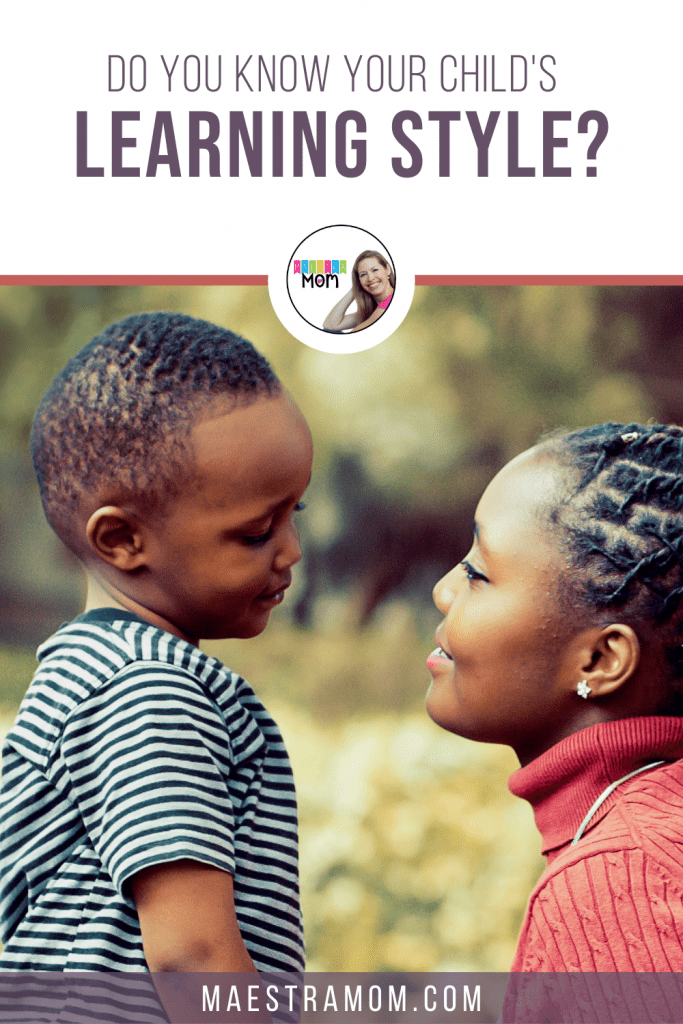Do you know your child’s learning style? We’ll explore four of the most common learning styles and see which one fits your child.
Any teacher who has worked with children can readily attest to the fact that not all kids learn in the same way. Every child is unique, and part of their individuality is how they process new information, often referred to as their learning style. As your child’s primary teacher, you will want to determine how your student learns best in order to set him up for a successful school year!
According to a 1992 study by Neil D. Fleming and Coleen E. Mills, there are four different learning styles that describe how children learn. You can use the acronym VARK to easily remember the four learning style modalities:
V – Visual
A – Auditory
R – Reading/Writing
K – Kinesthetic
A child may lean heavily towards one learning style, or be a mix of more than one. In fact, it is estimated that 50-70% of learners fall into more than one category. They often overlap each other, too! Which one sounds the most like your child?

Learning Style #1: Visual
Visual learners process new information best when it is presented in graphic depiction. These kids tend to learn more readily when information is presented in symbolic representation of the big picture. Visual learners intuitively understand charts, graphs, and diagrams. They often enjoy observing, doodling, and making lists to help them retain information. A pictogram might make more sense to a visual child than a paragraph in a book. These kids are often spatial thinkers and enjoy patterns, symbols, and shapes.
Teaching a Visual Learner
To connect with your visual learner keep a whiteboard handy and write or draw as you teach. Visual learners often benefit from taking notes or copying written words and symbols. These kids will respond well to flowcharts, graphs, pictures, icons, and diagrams. Let them create their own charts, too, to synthesize learning. Also utilize videos and materials rich in color and visuals. Also, be sure to let a child with a visual learning style create their own pictures and graphic depictions!
- Charts & diagrams
- Video
- Drawing
- Big Picture Graphic Overview
READ: Stop! Do You Know Your Child’s Reading Level?

Learning Style #2: Auditory
Auditory learners often listen intently but may seem lost in thought as if they weren’t really listening. (They are!) This is the child who seems checked out but can repeat back everything you just said when called. Sound familiar? Auditory learners like to listen to books read aloud and engage in discussion about their learning. These kids often need to talk out loud to reinforce their own learning and may have a hard time staying quiet. Auditory learners may be highly verbal and good at answering questions, but can sometimes be slower readers. Many auditory learners are also drawn to music.
Teaching an Auditory Learner
To reach your auditory learner, read books out loud or purchase audio books. Take advantage of books read aloud on YouTube and textbooks that come with a digital audio option, too. Some auditory learners prefer to learn with music in the background or, conversely, need noise-canceling headphones for total quiet. They may find noisy siblings or other learners highly distracting. Other tactics to reach auditory learners include utilizing verbal questions and answers, reading instructions aloud, as well as discussion and dialogue. Children with an auditory learning style typically enjoy educational songs and will also do well with video learning.
- Audio books
- YouTube
- Educational songs
- Verbal discussion
READ: Homeschool Math 10 Tips for a Smoother Day

Learning Style #3: Reading & Writing
A reading/writing learner is the most traditional learner and arguably the easiest to teach. These learners process new information through the written word. Thus, books, workbooks, and worksheets are all these kids need in order to learn. This kind of student may love reading and also enjoy writing as well as diving into new learning through research. A reading/writing learner may enjoy online text, too, as well as journaling to synthesize new information.
Teaching a Reading & Writing Learner
Use traditional materials such as textbooks and workbooks. Include regular trips to the library in your homeschool plans and set aside time for research using books and internet. Your child with a reading/writing learning style will benefit from book reports, research studies, essays, and journaling. Use handouts, slides, or a whiteboard when you teach to write new concepts so your student can take notes.
- Books
- Workbooks
- Writing
- Traditional schooling methods
READ: What’s Your Homeschool Style?

Learning Style #4: Kinesthetic
A kinesthetic learner absorbs new information through experiencing and doing. These learners need to touch, see, hear, smell, pull, twist, and explore materials in order to master concepts. Kinesthetic learners often seem wiggly, as if they just can’t sit still. They learn best through hands-on, interactive lessons. These kids want to be physically involved in the learning process, using their entire bodies to experience something new. Kinesthetic kids often excel at sports, martial arts, and dance, but may need frequent breaks in the classroom. They respond well to movement and real-life learning.
Teaching a Kinesthetic Learner
To connect with your kinesthetic learner, provide as many hands-on materials as possible. Include simulations, touchable models, and manipulatives for interactive learning. These kids do well with movement, so look for high energy educational movement songs or combining rote learning with exercise. Kids with a kinesthetic learning style like to engage in large motor activities such as writing big on the whiteboard or acting out a scene from a book. Provide opportunities to explore and do many hands-on experiments.and-on learning
- Field-trips
- Exploration
- Learn by doing
- Experiments
READ: 7 Free Online Homeschool Sites for Lessons, Flashcards, and Unit Studies

Which Learning Style to Use?
Children (and adults) seem to favor one or two of the four learning styles. Did any of them jump out as you as you were reading?
However, the most powerful teaching for children is when all of the learning styles are activated at once. Kids thrive when they can see, read, hear, say, and experience their new learning simultaneously in ways that are invigorating and exciting. Even if they have one learning style preference, they will benefit by experiencing all four modalities.
“Tell me and I forget, teach me and I may remember, involve me and I learn.”
Benjamin Franklin
If you’re a homeschool mom, keep in mind, too, that YOUR learning style might not match up with your child’s. For example, I’m a visual learner. My brain literally thinks in charts and big picture overviews. My closest friends tease me because I make charts for everything while my kids laugh because I’m forever saying, “come over here to the whiteboard”. Naturally, when it comes time to teach, I tend to make a picture for everything!
My firstborn child, however, has a reading and writing learning style, making traditional schooling seem easy. When my second child came along, we struggled in school until I realized he had a kinesthetic and auditory learning style combo. My third child seems to have more of a visual and reading/writing learning style combo and my fourth is still too little to peg. In our house, I have to teach in all the modalities if I have any hope of teaching them all!
So, stretch yourself this year to teach your child in ways that will make sense to his brain and not just your own. If something isn’t clicking, try teaching in a completely different learning style and see what happens. This year, make learning fun by intentionally targeting your child’s learning style and watch their minds come alive!


Pingback: How To Match Your Teaching Style to Your Kid’s Learning Style - Maestra Mom